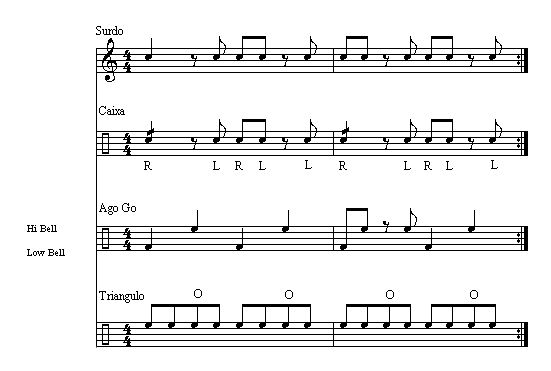
Phil Little's recent album, Samba Olimpicos, features many of the patterns on this website.
If you would like to start a Samba percussion Group or indeed any kind of Percussion Group and you don't know how to go about it see our Start Up page.

Note: These are very basic and simple patterns for beginners. We recommend you engage an experienced teacher to expand your knowledge. Try the UKSA register for contacts.
The Maracatu rhythm comes from the North Eastern state of Pernambuco and is said to be based on Coronation rites for African Kings and Queens.
It has an Ago Go pattern which is fairly straightforward and quite recognisable. Traditionally Maracatu doesn't include the Chocalho (or Shaker) and this provides an opportunity to try and get a different sound for part of your bateria's set.

Breaks can be short and simple or lengthy and highly arranged. One kind of break involves the rhythm stopping and a call and answer section being played by two or more sections,or, between the mestre and the rest of the band. Often there will be a call and answer section between the repenique and the rest of the group, or, between the repenique and the Surdo section. Then a short riff from thr repenique will pick up into the rhythm again.
A suggestion for somewhere to start when compiling your own break. Choose one of the parts from the rhythm and use it as a basis for a call and answer section. Often the Ago Go parts are useful for this as they flow and feature off beats. (if it sounds too similar to the main rhythm, try swapping round bars one and two). Have the repenique play the first bar and the rest of the group play the second bar then straight back into the rhythm. If this is too short play the call and answer four times (making 8 bars). Or, play the call and answer three times and over the last two bars the repenique solos and picks up into the main rhythm. These suggestions won't get you sounding like Mocidade but they might help a new players learn to organise arrangements. In future updates we will add notation for some more traditional breaks.
Dynamics can be acheived by lowering or raising the volume of the group, instigated by a signal from the mestre, or, by dropping out sections of the band. Maybe dropping down to one section and re-introducing the other sections gradually. A simple dynamic, for example, would involve playing the rhythm and all sections, except the Surdos, dropping out for four bars and then picking the rhythm up after the four bar 'drop out'. It is important that the Surdo section does not drop the tempo when it is left to play on it's own.
Dynamics and breaks can be used together to stunning effect and intelligent use can produce truly great arrangements.
Usually breaks are signalled by the Mestre who will be carrying a Apito (whistle) around his/her neck. The Apito may be used to signal a break or to play a part in the break. If you are really struggling to bring the band back in after a break, you can even blow one two three four to signal them in, but, you would probably want to replace that with something more musical at the earliest opportunity.
Update - This is a cool video from a Canadian group in Toronto from which you can copy the parts:-
https://www.youtube.com/watch?v=HXX3rNDm0zo
There used to be a website, maracatu.co.uk but that now directs to the Facebook page of Maracatu Estrela do Norte who are the leading Maracatu group in the UK.
If you would like to start a Samba percussion Group or indeed any kind of Percussion Group and you don't know how to go about it see our Start Up page.
Also, take a look at the Drums page on this site. There are some alternative patterns for Caixa or, if you are mixing it up, other patterns you can adapt to Bells, Tamborims or whatever.
I hope that you have found some of this useful. Let me know! Come back soon to check for updates.
E-mail phil@littledrum.co.uk
To return to main page click, HOME
All the material on this site is Copyright Phil Little